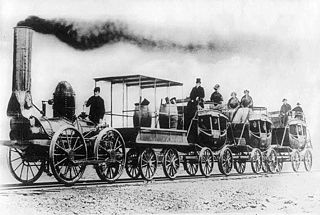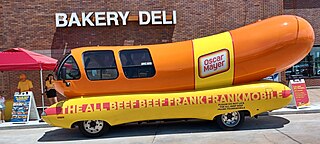
The Kraft Heinz Foods Company, formerly the H. J. Heinz Company and commonly known as Heinz, is an American food processing company headquartered at One PPG Place in Pittsburgh, Pennsylvania. The company was founded by Henry J. Heinz in 1869. Heinz manufactures food products in plants on six continents, and markets these products in more than 200 countries and territories. The company claims to have 150 number-one or number-two brands worldwide. Heinz ranked first in ketchup in the US with a market share in excess of 50%; the Ore-Ida label held 46% of the frozen potato sector in 2003.

The World's Columbian Exposition, also known as the Chicago World's Fair, was a world's fair held in Chicago from May 5 to October 31, 1893, to celebrate the 400th anniversary of Christopher Columbus's arrival in the New World in 1492. The centerpiece of the Fair, held in Jackson Park, was a large water pool representing the voyage that Columbus took to the New World. Chicago won the right to host the fair over several competing cities, including New York City; Washington, D.C.; and St. Louis. The exposition was an influential social and cultural event and had a profound effect on American architecture, the arts, American industrial optimism, and Chicago's image.

A Century of Progress International Exposition, also known as the Chicago World's Fair, was a world's fair held in the city of Chicago, Illinois, United States, from 1933 to 1934. The fair, registered under the Bureau International des Expositions (BIE), celebrated the city's centennial. Designed largely in Art Deco style, the theme of the fair was technological innovation, and its motto was "Science Finds, Industry Applies, Man Conforms", trumpeting the message that science and American life were wedded. Its architectural symbol was the Sky Ride, a transporter bridge perpendicular to the shore on which one could ride from one side of the fair to the other.

Ketchup or catsup is a table condiment with a sweet and sour flavor. "Ketchup" now typically refers to tomato ketchup, although early recipes for various different varieties of ketchup contained mushrooms, oysters, mussels, egg whites, grapes, or walnuts, among other ingredients.

The original Ferris Wheel, sometimes also referred to as the Chicago Wheel, was designed and built by George Washington Gale Ferris Jr. as the centerpiece of the Midway at the 1893 World's Columbian Exposition in Chicago, Illinois. Since its construction, many other Ferris wheels have been constructed that were patterned after it.

The DeWitt Clinton of the Mohawk and Hudson Railroad (M&H) was an American steam locomotive and the first working steam locomotive built for service in New York state.

Pabst Blue Ribbon, commonly abbreviated PBR, is an American lager beer sold by Pabst Brewing Company, established in Milwaukee, Wisconsin, in 1844 and currently based in San Antonio, Texas. Originally called Best Select, and then Pabst Select, the current name comes from the blue ribbons tied around the bottle's neck between 1882 and 1916.

Aunt Jemima was an American breakfast brand for pancake mix, table syrup, and other breakfast food products. The original version of the pancake mix was developed in 1888–1889 by the Pearl Milling Company and was advertised as the first "ready-mix" cooking product.

Oscar Mayer is an American meat and cold cut producer known for its hot dogs, bologna, bacon, ham, and Lunchables products. The company is a subsidiary of the Kraft Heinz Company and based in Chicago, Illinois.

A fleet of brandmobiles shaped like a hot dog on a bun, called "Wienermobiles", are used to promote and advertise Oscar Mayer products in the United States. The first Wienermobile was created by Oscar Mayer's nephew, Carl G. Mayer, in 1936. For a brief time in 2023, it was renamed the "Frankmobile" but due to popular demand, it was changed back to "Wienermobile."

Heinz 57 is a steak sauce. Its name comes from the historical advertising slogan "57 Varieties" by the H. J. Heinz Company located in Pittsburgh, Pennsylvania, United States. It was developed as part of a marketing campaign that told consumers about the numerous products available from the Heinz company.

A Chicago-style hot dog, Chicago Dog, or Chicago Red Hot is an all-beef frankfurter on a poppy seed bun, originating from the city of Chicago, Illinois. The hot dog is topped with yellow mustard, chopped white onions, bright green sweet pickle relish, a dill pickle spear, tomato slices or wedges, pickled sport peppers, and a dash of celery salt. The complete assembly of a Chicago hot dog is said to be "dragged through the garden" due to the many toppings. The method for cooking the hot dog itself varies depending on the vendor's preference. Most often they are steamed, water-simmered, or less often grilled over charcoal.

The Columbian half dollar is a coin issued by the Bureau of the Mint in 1892 and 1893. The first traditional United States commemorative coin, it was issued both to raise funds for the 1893 World's Columbian Exposition and to mark the quadricentennial of the first voyage to the Americas of Christopher Columbus, whose portrait it bears. The Columbian half dollar was the first American coin to depict a historical person.

Heinz Tomato Ketchup is a brand of ketchup manufactured by the H. J. Heinz Company, a division of the Kraft Heinz Company.

The SS Christopher Columbus was an American excursion liner on the Great Lakes, in service between 1893 and 1933. She was the only whaleback ship ever built for passenger service. The ship was designed by Alexander McDougall, the developer and promoter of the whaleback design.

A pin-back button or pinback button, pin button, button badge, or simply pin-back or badge, is a button or badge that can be temporarily fastened to the surface of a garment using a safety pin, or a pin formed from wire, a clutch or other mechanism. This fastening mechanism is anchored to the back side of a button-shaped metal disk, either flat or concave, which leaves an area on the front of the button to carry an image or printed message. The word is commonly associated with a campaign button used during a political campaign. The first design for a pin-back button in the United States was patented in 1896, and contemporary buttons have many of the same design features.

The Woman's Building was designed and built in June 1892, for the World's Columbian Exposition held in Chicago in 1893; under the auspices of the Board of Lady Managers. Out of the twelve main buildings for the Exhibition, the Woman's Building was the first to be completed. It had an exhibition space as well as an assembly room, a library, and a Hall of Honor. The History of the World's Fair states, "It will be a long time before such an aggregation of woman's work, as may now be seen in the Woman's Building, can be gathered from all parts of the world again." The purpose of the building was to highlight woman's achievements, and challenge the traditional ways of thinking at the time it was built. The Woman's Building was planned, designed, and decorated entirely by women under the direction of the board of lady managers.
Lydia Purdy Hess was an American artist best known for her Portrait of Miss E. H., which was exhibited at the Paris Salon de la Societé Nationale des Beaux-Arts, the Pennsylvania Academy of Fine Arts, and the World's Columbian Exposition in Chicago in 1893.

The Board of Lady Managers of the World's Columbian Exposition was organized November 19, 1890. It oversaw the construction of The Woman's Building in Chicago and organized the exposition's World's Congress of Representative Women (1893). A cookbook with autographed recipes of board members was also issued.


















